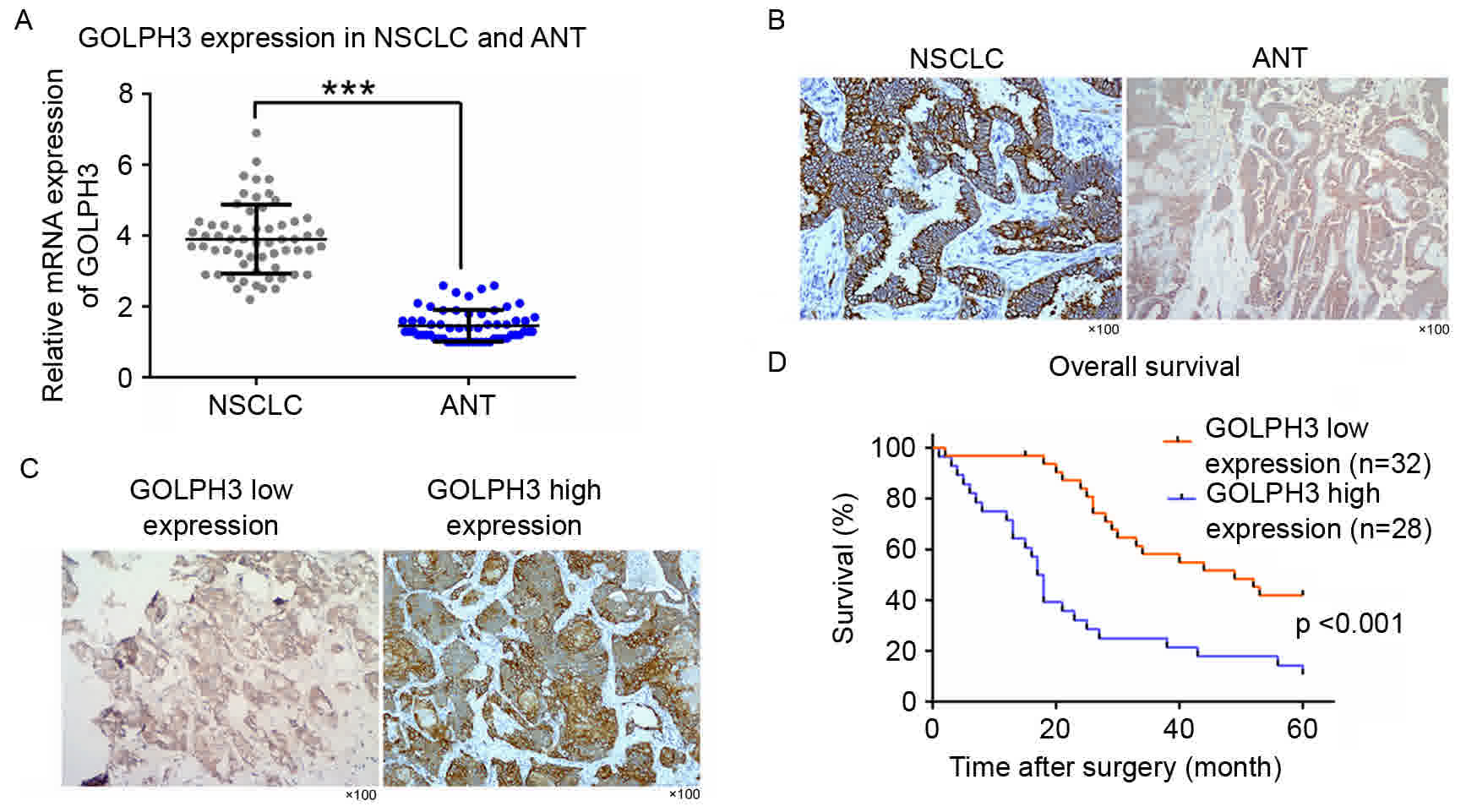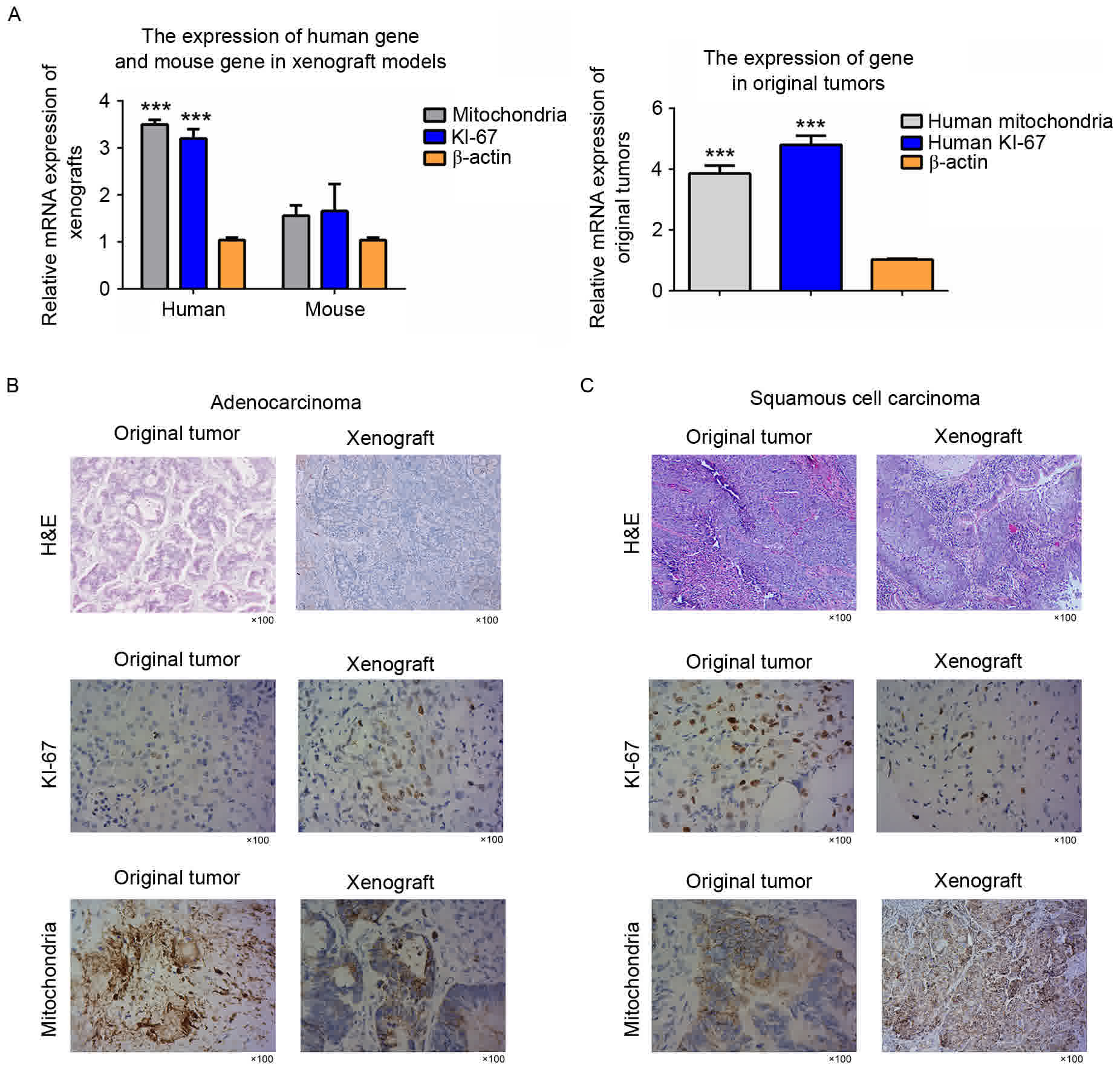|
1
|
Barton MK: Patients of all ages with
advanced non-small cell lung cancer are not receiving chemotherapy.
CA Cancer J Clin. 65:337–338. 2015. View Article : Google Scholar : PubMed/NCBI
|
|
2
|
Torre LA, Bray F, Siegel RL, Ferlay J,
Lortet-Tieulent J and Jemal A: Global cancer statistics, 2012. CA
Cancer J Clin. 65:87–108. 2015. View Article : Google Scholar : PubMed/NCBI
|
|
3
|
Siegel RL, Sahar L, Portier KM, Ward EM
and Jemal A: Cancer death rates in US congressional districts. CA
Cancer J Clin. 65:339–344. 2015. View Article : Google Scholar : PubMed/NCBI
|
|
4
|
Wu CC, Taylor RS, Lane DR, Ladinsky MS,
Weisz JA and Howell KE: GMx33: A novel family of trans-Golgi
proteins identified by proteomics. Traffic. 1:963–975. 2000.
View Article : Google Scholar : PubMed/NCBI
|
|
5
|
Dippold HC, Ng MM, Farber-Katz SE, Lee SK,
Kerr ML, Peterman MC, Sim R, Wiharto PA, Galbraith KA, Madhavarapu
S, et al: GOLPH3 bridges phosphatidylinositol-4-phosphate and
actomyosin to stretch and shape the Golgi to promote budding. Cell.
139:337–351. 2009. View Article : Google Scholar : PubMed/NCBI
|
|
6
|
Zhou J, Xu T, Qin R, Yan Y, Chen C, Chen
Y, Yu H, Xia C, Lu Y, Ding X, et al: Overexpression of Golgi
phosphoprotein-3 (GOLPH3) in glioblastoma multiforme is associated
with worse prognosis. J Neurooncol. 110:195–203. 2012. View Article : Google Scholar : PubMed/NCBI
|
|
7
|
Abraham RT: GOLPH3 links the Golgi network
to mTOR signaling and human cancer. Pigment Cell Melanoma Res.
22:378–379. 2009. View Article : Google Scholar : PubMed/NCBI
|
|
8
|
Scott KL, Kabbarah O, Liang MC, Ivanova E,
Anagnostou V, Wu J, Dhakal S, Wu M, Chen S, Feinberg T, et al:
GOLPH3 modulates mTOR signalling and rapamycin sensitivity in
cancer. Nature. 459:1085–1090. 2009. View Article : Google Scholar : PubMed/NCBI
|
|
9
|
Buschman MD, Rahajeng J and Field SJ:
GOLPH3 links the Golgi, DNA damage, and cancer. Cancer Res.
75:624–627. 2015. View Article : Google Scholar : PubMed/NCBI
|
|
10
|
Tang W, Han M, Ruan B, Jin W, Lou J, Yuan
X, Chen D, Chen Y, Shin VY, Jin H and Wang X: Overexpression of
GOLPH3 is associated with poor survival in Non-small-cell lung
cancer. Am J Transl Res. 8:1756–1762. 2016.PubMed/NCBI
|
|
11
|
Hua X, Yu L, Pan W, Huang X, Liao Z, Xian
Q, Fang L and Shen H: Increased expression of Golgi
phosphoprotein-3 is associated with tumor aggressiveness and poor
prognosis of prostate cancer. Diagn Pathol. 7:1272012. View Article : Google Scholar : PubMed/NCBI
|
|
12
|
Feng Y, He F, Wu H, Huang H, Zhang L, Han
X and Liu J: GOLPH3L is a novel prognostic biomarker for epithelial
ovarian cancer. J Cancer. 6:893–900. 2015. View Article : Google Scholar : PubMed/NCBI
|
|
13
|
Zhu K, Zhao Q, Yue J, Shi P, Yan H, Xu X
and Wang R: GOLPH3 overexpression correlates with poor response to
neoadjuvant therapy and prognosis in locally advanced rectal
cancer. Oncotarget. 7:68328–68338. 2016. View Article : Google Scholar : PubMed/NCBI
|
|
14
|
Xue Y, Wu G, Liao Y, Xiao G, Ma X, Zou X,
Zhang G, Xiao R, Wang X, Liu Q, et al: GOLPH3 is a novel marker of
poor prognosis and a potential therapeutic target in human renal
cell carcinoma. Br J Cancer. 110:2250–2260. 2014. View Article : Google Scholar : PubMed/NCBI
|
|
15
|
Zeng Z, Lin H, Zhao X, Liu G, Wang X, Xu
R, Chen K, Li J and Song L: Overexpression of GOLPH3 promotes
proliferation and tumorigenicity in breast cancer via suppression
of the FOXO1 transcription factor. Clin Cancer Res. 18:4059–4069.
2012. View Article : Google Scholar : PubMed/NCBI
|
|
16
|
Seol HS, Suh YA, Ryu YJ, Kim HJ, Chun SM,
Na DC, Fukamachi H, Jeong SY, Choi EK and Jang SJ: A
patient-derived xenograft mouse model generated from primary
cultured cells recapitulates patient tumors phenotypically and
genetically. J Cancer Res Clin Oncol. 139:1471–1480. 2013.
View Article : Google Scholar : PubMed/NCBI
|
|
17
|
Cutz JC, Guan J, Bayani J, Yoshimoto M,
Xue H, Sutcliffe M, English J, Flint J, LeRiche J, Yee J, et al:
Establishment in severe combined immunodeficiency mice of subrenal
capsule xenografts and transplantable tumor lines from a variety of
primary human lung cancers: Potential models for studying tumor
progression-related changes. Clin Cancer Res. 12:4043–4054. 2006.
View Article : Google Scholar : PubMed/NCBI
|
|
18
|
Morton CL and Houghton PJ: Establishment
of human tumor xenografts in immunodeficient mice. Nat Protoc.
2:247–250. 2007. View Article : Google Scholar : PubMed/NCBI
|
|
19
|
van Kempen LC, Ruiter DJ, van Muijen GN
and Coussens LM: The tumor microenvironment: A critical determinant
of neoplastic evolution. Eur J Cell Biol. 82:539–548. 2003.
View Article : Google Scholar : PubMed/NCBI
|
|
20
|
Wang Y, Revelo MP, Sudilovsky D, Cao M,
Chen WG, Goetz L, Xue H, Sadar M, Shappell SB, Cunha GR and Hayward
SW: Development and characterization of efficient xenograft models
for benign and malignant human prostate tissue. Prostate.
64:149–159. 2005. View Article : Google Scholar : PubMed/NCBI
|
|
21
|
Lee CH, Xue H, Sutcliffe M, Gout PW,
Huntsman DG, Miller DM, Gilks CB and Wang YZ: Establishment of
subrenal capsule xenografts of primary human ovarian tumors in SCID
mice: Potential models. Gynecol Oncol. 96:48–55. 2005. View Article : Google Scholar : PubMed/NCBI
|
|
22
|
Zhang XC, Zhang J, Li M, Huang XS, Yang
XN, Zhong WZ, Xie L, Zhang L, Zhou M, Gavine P, et al:
Establishment of patient-derived non-small cell lung cancer
xenograft models with genetic aberrations within EGFR, KRAS and
FGFR1: Useful tools for preclinical studies of targeted therapies.
J Transl Med. 11:1682013. View Article : Google Scholar : PubMed/NCBI
|
|
23
|
Rygaard J and Povlsen CO:
Heterotransplantation of a human malignant tumour to ‘Nude’ mice.
Acta Pathol Microbiol Scand. 77:758–760. 1969. View Article : Google Scholar : PubMed/NCBI
|
|
24
|
Fichtner I, Rolff J, Soong R, Hoffmann J,
Hammer S, Sommer A, Becker M and Merk J: Establishment of
patient-derived non-small cell lung cancer xenografts as models for
the identification of predictive biomarkers. Clin Cancer Res.
14:6456–6468. 2008. View Article : Google Scholar : PubMed/NCBI
|
|
25
|
Perez-Soler R, Kemp B, Wu QP, Mao L, Gomez
J, Zeleniuch-Jacquotte A, Yee H, Lee JS, Jagirdar J and Ling YH:
Response and determinants of sensitivity to paclitaxel in human
non-small cell lung cancer tumors heterotransplanted in nude mice.
Clin Cancer Res. 6:4932–4938. 2000.PubMed/NCBI
|
|
26
|
Nolen RS: AVMA board approves panel on
euthanasia report: Updated guidelines cover more species and
methods. J Am Vet Med Assoc. 239:12692011.PubMed/NCBI
|
|
27
|
Delgado-Ruiz RA, Guirado Calvo JL and
Romanos GE: Bone grafting materials in critical defects in rabbit
calvariae. A systematic review and quality evaluation using ARRIVE
guidelines. Clin Oral Implants Res. 26:915–930. 2015. View Article : Google Scholar : PubMed/NCBI
|
|
28
|
Marshman E, Ottewell PD, Potten CS and
Watson AJ: Caspase activation during spontaneous and
radiation-induced apoptosis in the murine intestine. J Pathol.
195:285–292. 2001. View
Article : Google Scholar : PubMed/NCBI
|
















